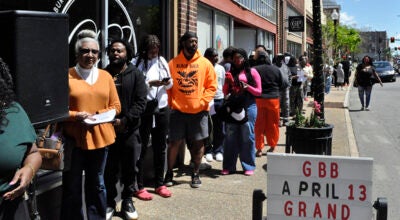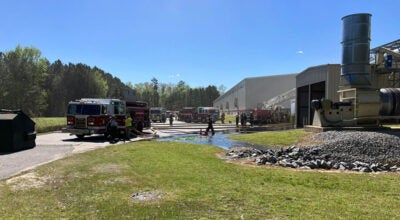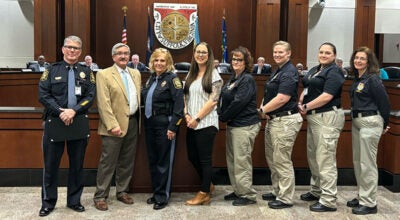Pruden proposal tabled
Published 8:05 pm Thursday, June 20, 2019
Concerned about how the city calculates proffer amounts for elementary schools, Suffolk Council voted Wednesday to table a proposed rezoning request that would bring a 414-unit development off of Pruden Boulevard.
By a 5-3 vote, with Vice Mayor Leroy Bennett and Councilmen Tim Johnson and Lue Ward dissenting, Council voted to table the proposal until Jan. 15, 2020, in order to give city staff time to develop a more reliable methodology to determine student population changes when developments are proposed.
Councilman Roger Fawcett made the motion to table the proposal, citing the need for a study.
“It’s a good project,” Fawcett said. “We all know it’s a good project, but … I just don’t want to put it out there for failure.”
If the rezoning had been denied, the developer would have had to wait for a year before bringing it back to the city again.
City Manager Patrick Roberts said he wants have a third-party study of the student-generation rates.
“I want to collaborate with the School Board to develop a more jointly agreed upon set of facilities priorities where I thought the Council should invest money, and at the same time … better predict student enrollment and better align those predictions with housing types,” Roberts said.
The subject will be a topic of discussion at the joint meeting between the School Board and City Council July 17, and Roberts said it is an issue he wants to work through over the course of the year.
The developer of the Pruden Boulevard property, known as Hallstead Reserve, defended the proposed rezoning during a public hearing, and in particular, defended the proffer for the number of elementary school students it expects to generate.
The rezoning would affect 48 of the property’s 57 acres at 2575 and 2665 Pruden Blvd., near Murphys Mill Road. The property is currently zoned general commercial and, if approved, would be rezoned to residential urban.
The Planning Commission had voted 6-2 in May to recommend denial of the request.
John Napolitano, owner of Napolitano Homes of Virginia Beach, said the process had changed several times in the generation of proffer amounts for elementary schools, and he proposed a total of $2.2 million. The Hallstead Reserve development proposed would serve an already-overcrowded Elephant’s Fork Elementary School, which is at 111 percent of its capacity and has 567 students, with 13 trailers in use, according to Suffolk Public Schools.
With 82 students generated by other committed development assigned to the school, Elephant’s Fork would be 151 students overcapacity.
While a new downtown elementary school is in the adopted 2020-2029 Capital Improvements Program and Plan, it is not set for funding until sometime between 2025 and 2029.
Napolitano said he thinks the proposed Hallstead Reserve development would, after an additional proffer to build 102 four-plex housing units with master bedrooms on the first floor for an age-targeted population, generate just four to six elementary school students.
David Hainley, the director of planning and community development, said that the new proffer did not define the age range for people who would occupy the 102 units, and that the developer would not be forced to keep those units age-targeted.
However, Napolitano said in another of his Suffolk developments, Bennetts Creek Square, there are 52 age-targeted homes — with two elementary school students coming from them — out of the 189 homes there, and just five elementary school students got off of a bus, according to his observation.
“Based on real-world evidence, in a community that we built, (it) shows that we will not produce the number of elementary school students that the calculation says we will,” Napolitano said.
Fawcett, who said he lives in the Bennetts Creek Square neighborhood, backed up Napolitano’s observation.
“These quads don’t generally generate a lot of students,” Fawcett said.
Napolitano, in seeking a residential development, said he had reached out to more than 12 commercial entities, and “all turned us down.” He said Hallstead Reserve would be a part of downtown’s revitalization.
“We realize we did not receive a positive recommendation from the staff, and that is due to the elementary school,” Napolitano said. “As you all are very well aware of, it’s a long way from concept to getting before council.”
Napolitano said when the project was first proposed in May 2018, there would have to be a proffer for both elementary school and high school students. At that time, the elementary school proffer was $16,495 per student, he said, “a reasonable amount.” The high school proffer at the time, he said, was $28,679.
Napolitano said he was later told that the high school proffer would no longer be necessary, and that the elementary school proffer had increased to $41,666 per student. He said the city looked at that and adjusted the number down to $33,125 per student, but said he did not agree with how the city determined its proffer amount.
Councilman Mike Duman, who is supportive of Napolitano’s project and the rezoning, noted the need for a study.
“I think what we need to do is have that comprehensive study done, meet with our partners in the local industry, meet with the school system, come up with a number that everybody can agree upon, and then once we agree upon that number, then it’s going to be etched in stone,” Duman said.
“I think it’s a good project,” Duman continued. “I don’t see any other issues with it. … I don’t believe that this development will increase the student population to the extent that it was presented.”
However, while agreeing with Duman about not being sure about the number of students that would be generated from the project, Councilman Tim Johnson said that with 7,000 homes in the pipeline, he did not feel comfortable supporting the rezoning.
“I’m so disturbed that we allow things to go forward that we’re not ready for,” Johnson said.
Mayor Linda T. Johnson said she has visited Elephant’s Fork and knows it’s overcrowded, but said she didn’t have an issue with the nature of the project.
“I think the project is good,” she said. “The problem is truly not necessarily with the developers. It is ours. It’s the city’s problem.
“But my bigger problem is, we’re the ones that set that policy. So here we are almost trying to reinvent the wheel and it almost looks like we’re doing that for this specific purpose, and I just feel philosophically that, what we need to do up here is to do a policy that works, that’s right. And if we truly believe that this is wrong, and I think that most of us think that (the proffer) is kind of high. But the one thing we have to remember is that schools aren’t getting any cheaper.”





